In soccer, unlike hockey or basketball, players do not continuously sprint at full speed. It’s common for two players to remain stationary while passing the ball back and forth. The quality of the turf they stand on can significantly impact the game. As players strategize and prepare for their next move, the surface of the artificial grass affects ball control.
Synthetic grass is designed to mimic natural grass, but it still differs from traditional grass fields. Evaluating the quality of synthetic turf involves considering various factors, especially when installing it in a stadium.
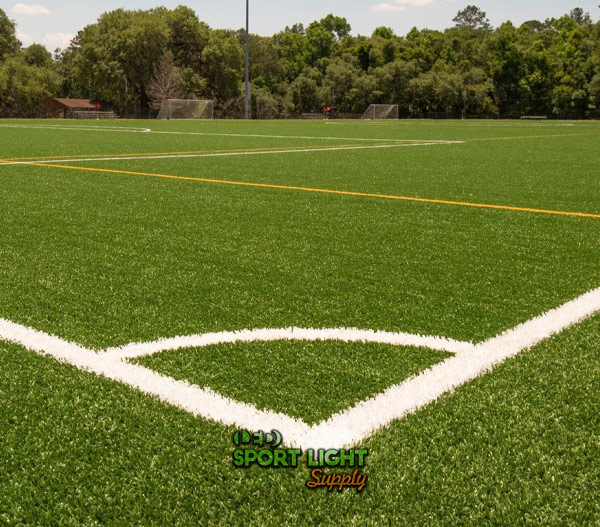
Table of Contents
ToggleAbout the Content of This Soccer Turf Guide
This guide is designed to provide comprehensive insights into selecting the best artificial grass for soccer fields. It covers essential characteristics of FIFA-approved turf systems and offers guidance on understanding the differences between natural and synthetic grass. You will also learn about the applications for outdoor and indoor soccer fields, the materials and features that distinguish high-quality from low-quality products, and the process of replacing soccer turf. Additionally, common questions are addressed to ensure all relevant topics are covered.
Artificial vs. Natural Soccer Turf
The Impact of Playing Surface
The pace and style of a soccer game are significantly influenced by the playing surface. While players frequently pass the ball with precision, the game can shift to rapid bursts of speed and action. Soccer players may cover seven to ten miles in a single game, making them constantly positioned for potential scoring opportunities.
The constant action leads to wear and tear on the soccer pitch. Natural grass may develop bare spots and dirt clods from heavy foot traffic, while synthetic turf can experience seam ruptures under intense use. Understanding these differences helps in choosing the right type of turf for your needs.
Depth and Pile Height vs. Maintenance
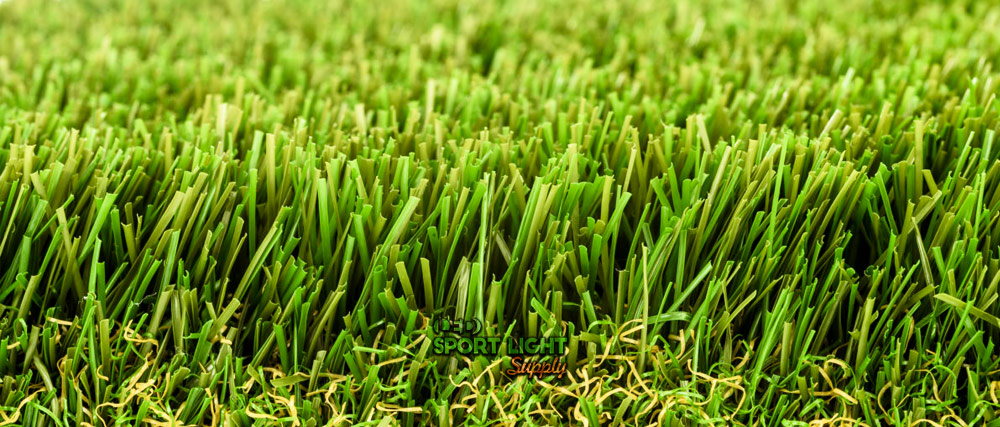
Depth of Synthetic Turf
The depth of synthetic turf is crucial in replicating the feel of natural grass. Natural grass grows from the ground, and its quality can be assessed based on the soil’s condition. In contrast, synthetic turf requires careful consideration of depth during manufacturing. Shallow turf resembles a rough carpet and may cause discomfort, while deeper, high-quality artificial grass features soft plastic blades and infill materials such as sand or rubber pellets to enhance stability and cushioning. This design improves ball bounce and provides a more comfortable playing surface.
Maintenance Requirements
Maintaining natural grass involves regular mowing, fertilizing, and overseeding to keep it in optimal condition. This ongoing maintenance can be time-consuming and costly. In contrast, synthetic grass requires minimal maintenance. The height of the grass blades and stitch rate can be customized upon purchase, and the turf remains consistent in color and quality over time.
Repairs vs. Overseeding
Repairing Synthetic Turf
Repairing synthetic turf may involve using seaming tape, glue, staples, and other materials. In severe cases, replacing entire sections of turf might be necessary. High-quality synthetic turf often comes with a 15-year warranty, although repairs can be challenging to perform independently.
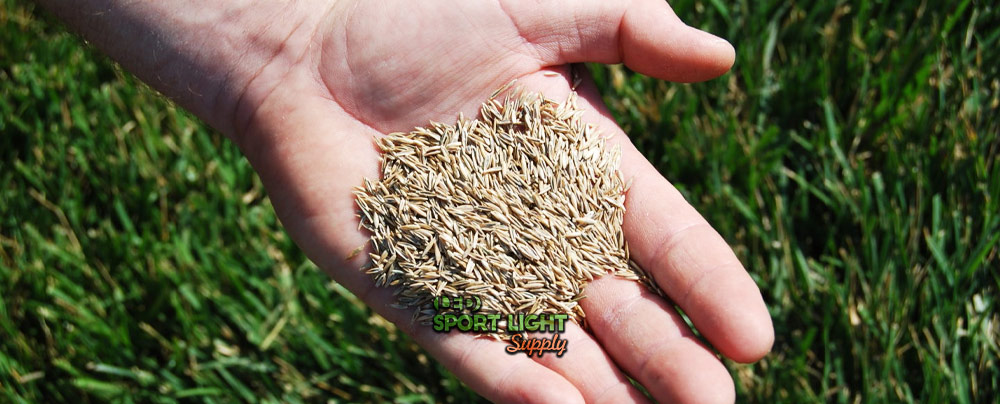
Seeding and Overseeding Natural Grass
Seeding and overseeding natural grass require significant time and effort. The process involves the cost of SOD grass seeds and dealing with potential issues such as germination delays and weather-related challenges. Additionally, hiring professional lawn care services for cutting and fertilizing can be expensive, especially for larger fields.
Soccer Boots for Authentic and Synthetic Grass
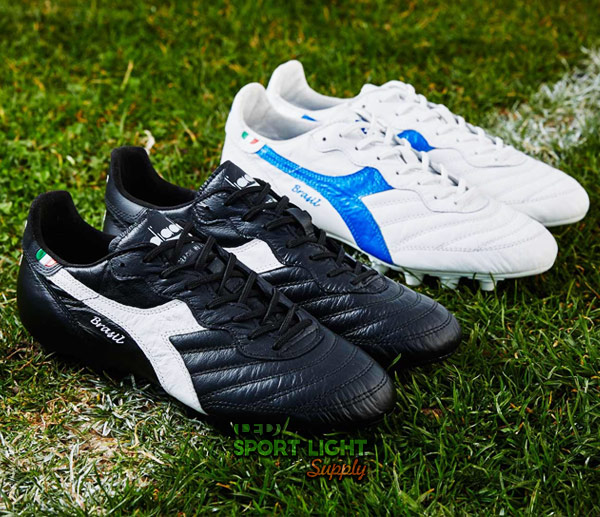
Footwear for Shallow Turf
Players using shallow artificial turf should wear turf shoes with a flat outsole and small rubber nubs for traction. These shoes are designed for consistent performance on such surfaces.
Footwear for Deeper Turf
For deeper synthetic grass, soccer boots with studs are recommended to provide optimal traction. However, firm ground boots designed for natural grass should not be used on synthetic surfaces, as they can be unsafe and may cause premature wear. Instead, AG (Artificial Grass) boots with specific stud patterns are ideal for synthetic fields. Each brand offers variations, such as mixed FG/AG stud styles, to suit different playing conditions.
Outdoor vs. Indoor Soccer Field Turf
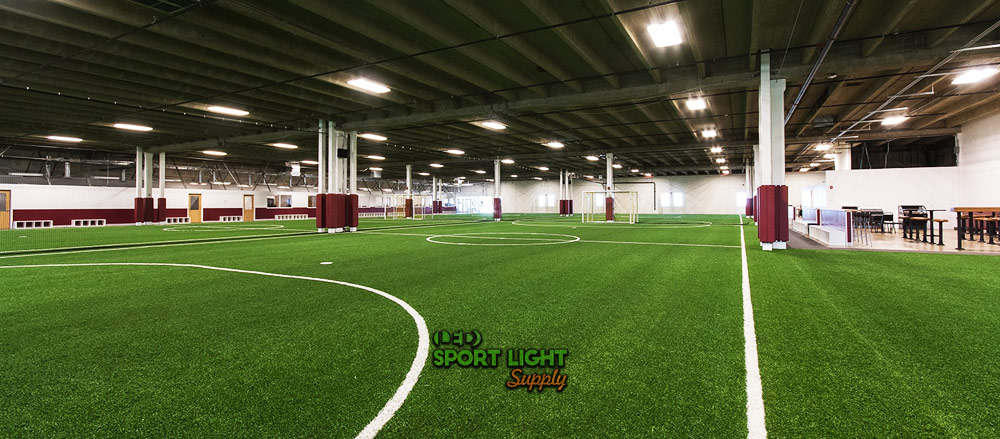
Outdoor Artificial Soccer Field Turf
Installing artificial turf for outdoor soccer fields involves a meticulous process to ensure the highest quality construction. The installation process begins with unloading the turf rolls and positioning them according to the installation drawing. Professional forklifts are used to place the rolls accurately, and the outline of the pitch is marked based on the specified dimensions.
Depending on the size and condition of the facility, the installation can take several days, especially if old turf needs to be removed. This may involve severing seams and scraping residues from the base.
Starting the Installation
When setting up artificial turf, the first step is to consider the scope of the project. For top-level football pitches, incorporating soft shock pads is standard practice, whether the field is indoor or outdoor. Ensuring that the turf is properly aligned and straightened is crucial.
For outdoor installations, land leveling is essential. Drainage systems are then set up, often achieved by applying a 1-2% slope from one side to the other or from the center to the corners. A geotextile fabric layer is used to prevent wild plants from growing underneath the turf, which helps maintain the field’s condition and extends its lifespan. Despite the higher initial cost compared to natural grass, artificial turf offers a good return on investment over 10 to 12 years.
Rainfall Percolation
Synthetic turf with high-quality backing ensures excellent drainage. Manufacturers typically perforate the backing with holes every 6 inches, and the tufted threads allow rain to pass through. A crushed rock aggregate beneath the turf enhances drainage efficiency, allowing the field to dry faster than natural grass. After heavy rain, the pitch may feel wet but will remain solid and free from squishiness. Proper installation includes managing drain pipes beneath the aggregate to prevent water accumulation.
Converting Concrete to Turf
Converting a concrete surface into a functional soccer training facility involves specific considerations. Many facility owners opt to glue the turf directly to the concrete, using a rubber and sand infill system to increase cushioning. However, gluing the turf can complicate future expansions or repairs.
An alternative approach involves using anchoring panels, which are designed to fit within existing rink confines or around walls. These panels make the installation process more flexible but may require more time. The standard seaming procedure completes the installation, and high energy restitution rates make these solutions ideal for soccer.
Indoor Artificial Soccer Field Turf
Indoor soccer fields require careful consideration of different factors compared to outdoor installations. The choice of turf, installation methods, and maintenance practices all play a crucial role in ensuring the field meets the required standards for performance and durability.
Anatomy of Synthetic Turf
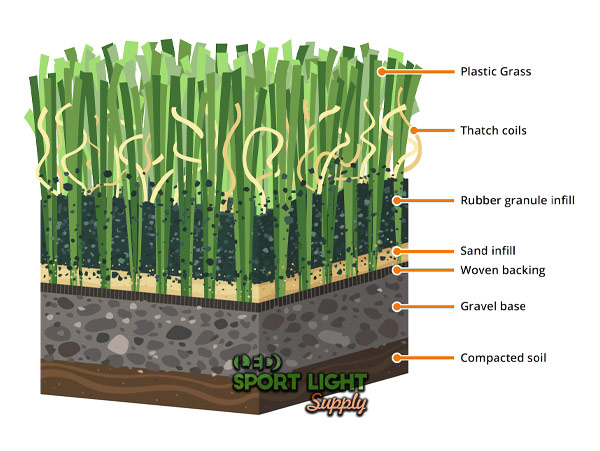
The Backing System
The drainage capabilities of synthetic turf are largely determined by the backing system. Proper drainage is crucial for maintaining playability and safety, as poor drainage can lead to water accumulation and attract pests. The backing system allows water to pass through and reach the underlying soil, preventing odor buildup and reducing the need for additional cleaning chemicals.
There are three primary types of backing systems used in synthetic turf:
| Drainage System | Description | Advantages | Disadvantages |
|---|---|---|---|
| Permeable Felt-Like Drainage | Connects a permeable felt-like layer to tufted artificial fibers. Absorbs moisture until saturated, then drains. | Effective at absorbing and draining moisture. | Water may back up if the layer becomes saturated. |
| Hole-Punched Drainage | Features punched or burned holes through the turf backing, spaced 4 to 6 inches apart. | Allows for drainage through the holes. | Areas without holes are not permeable. |
| Patented Drainage Systems | Includes numerous microscopic holes within a solid-state backing, ensuring superior permeability. | High permeability and minimal absorption. | Generally more expensive. |
To evaluate the effectiveness of each system, conduct a test by flowing water over the backing. You’ll notice that water backs up more quickly on hole-punched and felt-like backings compared to patented systems. Investing in high-quality backing is advisable, particularly for outdoor installations.
Grass Fiber
The quality of the grass fiber significantly impacts the turf’s performance. Grass fibers are designed to mimic natural grass, but their abrasive qualities can affect player comfort and safety. For example, falling on synthetic turf can lead to injuries or abrasions, which are less common with natural grass.
The yarn type and tuft bind of the grass fiber also influence ball roll and playability. The goal is to maintain possession and execute precise passes, which can be affected by variations in the turf.
Common materials used for grass fibers include Nylon, Polyethylene, and Polypropylene:
| Fiber Type | Description | Advantages | Disadvantages |
|---|---|---|---|
| Nylon | Inexpensive and typically suited for indoor use. However, it is known for its abrasive nature. | Cost-effective for indoor applications. | Less ideal due to abrasiveness. |
| Polyethylene | Offers UV resistance and a more natural look and feel, making it suitable for outdoor fields. | Natural appearance and durability outdoors. | None significant. |
| Polypropylene | Commonly used in backing, does not absorb water, and is durable. However, it is less common in grass fibers. | Water-resistant and durable. | Less common in grass fiber; not as ideal for all applications. |
Infill
Infill material plays a crucial role in the performance and longevity of synthetic turf. It helps support the grass blades and can include additional features like antibacterial properties. Common infill materials are silica sand and crumb rubber.
The installation of infill involves spreading and brushing the material across the turf. Typically, this requires two passes: one for spreading the initial layer and another for adding additional infill if needed. Using a lawn drop spreader ensures even distribution, and a stiff-bristled broom or power broom helps work the infill into the grass blades. Spraying the turf to remove dust and reduce static is also recommended.
Padding
Padding is essential for shock absorption and player safety. It can be installed using tools such as a hot air gun, tape, snap line, ruler, knife, and pressing materials. For outdoor installations, rolls of padding are common, while panels may be used for indoor fields, especially on concrete floors.
Foam underlay provides cushioning, reducing the risk of injuries such as ankle sprains and hamstring strains. High-performance shock pads help improve player safety and comfort. Ensure that the padding meets relevant standards, such as UNI EN 15330-1:2013 in Europe, and consider additional local requirements.
Effects of Grass Turf on Athletes
Athletic injuries vary in severity, ranging from common strains to serious injuries that require surgery and lengthy recovery. The type of playing surface can significantly influence the risk and nature of these injuries.
Historically, older artificial turfs, such as Astroturf, were associated with a higher incidence of injuries. However, advancements in turf technology have improved safety. Modern synthetic turf systems feature infill surfaces with synthetic grass blades and rubber pellets, but these materials may present health risks.
Research on the relationship between synthetic turf and injuries has produced mixed results. Some studies indicate higher rates of anterior cruciate ligament (ACL) tears on artificial surfaces, while others find no significant difference when compared to natural grass. Factors influencing these outcomes include weather conditions, the time of the game, and the type of footwear used.
Health Concerns About Rubber Infill
Rubber infill, often made from recycled tires, poses potential health risks. Tires contain over 20 hazardous chemicals, including:
| Chemical | Health Impact |
|---|---|
| Cadmium | Carcinogen |
| Arsenic, Benzene, Fluoranthene | Carcinogens |
| Benzothiazole | Toxic, irritant to respiratory system and eyes |
| Carbon nanotubes | Potentially asbestos-like toxicity |
| Manganese, Mercury | Neurotoxins |
| Octylphenol | Endocrine disruptor |
Choosing safer infill materials is crucial to mitigate these risks.
FIFA Certified Artificial Grass and Performance
FIFA certification ensures that artificial soccer fields meet stringent performance standards. The certification process includes:
| Test | Purpose |
|---|---|
| Slope, Evenness, and Permeability Testing | Ensures optimal drainage and a smooth surface. |
| Roll Stretching and Seaming | Prevents bumps and maintains aesthetic integrity. |
| Vertical Deformation and Ball Rolling Tests | Measures the bounce and behavior of the ball on the surface. |
| Rotational Resistance Tests | Evaluates how the surface affects players’ legs during play. |
| Shock Absorption and Energy Restitution Testing | Assesses the surface’s softness and hardness, impacting game quality. |
Tips for Replacing Soccer Turf
Replacing soccer turf can be a necessary task to ensure the safety and functionality of the playing surface. Here are some essential considerations and steps to follow for a successful replacement:
Assessing the Need for Replacement
While artificial turf may initially look well-maintained, visible damage or wear can compromise its safety and appearance. If the turf has become unsafe or unsightly, replacing it might be necessary. Issues such as discoloration or significant damage can often be addressed through replacement rather than repair.
Matching Color and Coating
When replacing turf, it is crucial to select a new artificial grass that matches the existing color. New soccer turf typically has a rich, dark green hue, particularly if it is for an indoor facility. To maintain a consistent look, ensure the new turf’s color matches that of the old turf.
The grass fibers on new artificial turf are coated with chemicals to resist UV-induced discoloration. However, this coating generally lasts only about three months. After this period, the true color of the turf becomes apparent. It is advisable to test samples of different turfs to find a close match. Suppliers usually provide samples to help in this selection process.
DIY Repairs and Installation
If you choose to handle the turf replacement yourself, follow these steps for a successful installation:
| Task | Description |
|---|---|
| Stretching the Turf | Begin by stretching the artificial turf roll into position. Use galvanized nails to secure the turf in place. Start from one end and work your way to the other, ensuring the turf is stretched evenly. |
| Nailing the Turf | Use 6-inch galvanized nails to anchor the turf. To avoid damaging the grass blades, pull back the blades slightly with one nail before hammering it down. Position nails primarily around the edges and perimeters, as these areas are more prone to lifting or coming loose. |
| Making Clean Cuts | Precision in cutting the turf is essential. Clean, accurate cuts ensure a seamless appearance. Avoid errors as replacement material may not be readily available. If a seam is necessary, ensure it is done neatly to maintain the field’s overall appearance. |
Choosing the Best Soccer Turf Suppliers
When selecting a soccer turf supplier, proximity to your location can be crucial, particularly if you need to address issues like turf replacement under warranty. While many soccer turf suppliers source their products from China, having a nearby supplier can facilitate easier claims and quicker resolutions in case of problems.
Evaluating Soccer Turf Suppliers
The best soccer turf suppliers cater to various needs depending on the level of play. For stadiums hosting top-professional athletes, it is essential to choose suppliers whose products meet FIFA standards. High-quality suppliers focus not only on the turf itself but also on the infill material, which plays a significant role in player safety.
The right infill material enhances safety by cushioning impacts, which is crucial for both professional and amateur athletes. As such, high school athletic directors and other decision-makers have numerous options to choose from, with ample information available online to guide their choices.
Considerations for Price and Budget
The amount and type of infill directly impact the safety and performance of the turf, but they also affect the overall cost. While heavier and more substantial infill options generally provide better safety features, they come with a higher price tag. Balancing safety with budget constraints is an important aspect of the decision-making process.
A detailed bid proposal can help ensure that you get a turf system that meets both safety and budgetary requirements. The proposal should outline your priorities, including the specific features that will create a safe and durable environment for players or student-athletes.
Soccer Field Turf: Questions and Answers
How is Synthetic Grass Made?
Synthetic grass has evolved significantly since the introduction of astroturf in the 1960s. The process of manufacturing modern synthetic turf begins with white plastic pellets, which serve as the base material. Green pellets are added to provide color, along with chemical stabilizers and additives.
Industrial equipment melts the plastic and extrudes it through a steel plate with holes to create green fiber strands. These strands are then cooled and solidified by a water jet. The synthetic yarn is then fed through a tufting machine, which hooks the strands into a meshed backing and cuts them to resemble grass blades. After inspection for uniformity, a coating roller binds the yarn to the backing, and hot pins create perforations to ensure drainage.
Different manufacturers use specific machines and patented technologies, resulting in variations in quality from brand to brand.
How is the New Generation of Artificial Grass Different?
The latest artificial grass products are distinct from their predecessors in several ways. Unlike earlier versions with simple grass fibers, modern turfs feature c- or v-shaped blades that enhance resilience and mimic natural grass more closely. These advanced fibers contribute to improved safety, reducing the risk of injuries for players.
Contemporary turfs are also designed with better UV stabilization, ensuring they retain their green color longer. They often incorporate multi-colored yarns to enhance realism and innovative coatings that reduce heat storage by up to 20% compared to earlier models. The design process now involves computer simulations to refine the appearance and performance of the turf before production begins.
Modern artificial grass is engineered to meet soccer association standards, offering a softer playing surface and a range of features tailored to current requirements. This focus on quality and safety has led to a wider range of high-quality products, though prices can vary.
Why Has Artificial Grass Gained Popularity Recently?
The recent surge in the popularity of artificial grass can be attributed to its many advantages. Artificial turf provides a stable and consistent playing surface, making it suitable for use in various weather conditions, including winter. Its durability is a key factor, with many synthetic turfs designed to withstand up to 100 hours of play per week and backed by warranties of 15 years or more.
Artificial grass offers an inclusive solution for creating accessible playing fields and can be installed in locations where natural grass would be impractical. Modern installation techniques ensure a smooth transition with no trip hazards, making it ideal for both indoor and outdoor soccer pitches.
Should I Groom My Artificial Soccer Field Sample?
Grooming artificial grass samples is essential for accurately assessing the quality of the turf. When you receive a sample, it may appear matted, so proper grooming is necessary.
To groom the sample:
| Task | Description |
|---|---|
| Gather Tools | You will need sharp scissors and a pen or marker. |
| Trim the Edges | Cut the grass along the edges of the backing to reveal a more representative sample. |
| Mark the Grooves | Use the pen to trace the grooves between the stitch rows. Run the pen or marker along the length of each groove. |
This process will help you evaluate the turf more effectively. After installation, using a power broom will assist in maintaining the appearance and performance of the soccer field.
Conclusion
Synthetic grass offers durability and low maintenance but differs from natural grass in feel and upkeep. This guide has provided a thorough overview of evaluating, installing, and maintaining soccer turf, including the key factors to consider for both outdoor and indoor fields. By understanding these elements, you can make informed decisions that align with your needs and ensure a high-quality playing surface for optimal game conditions.
